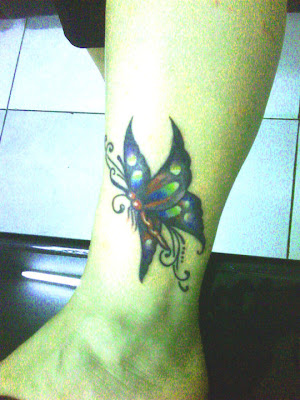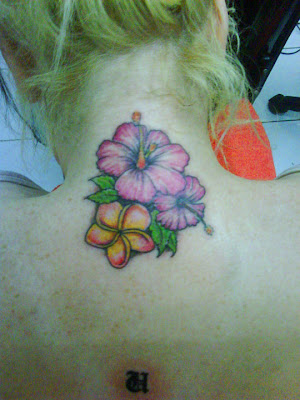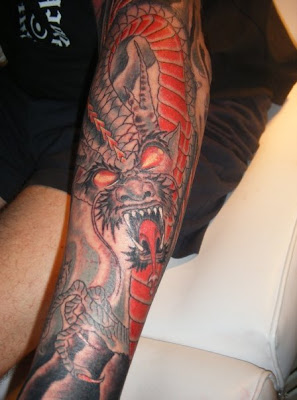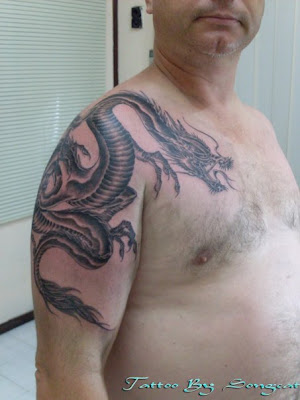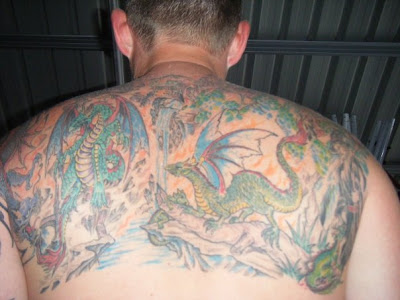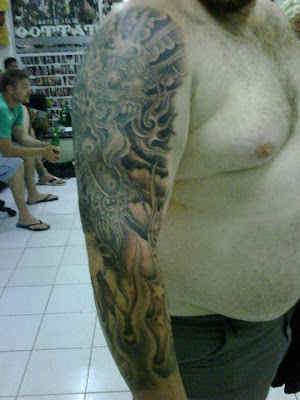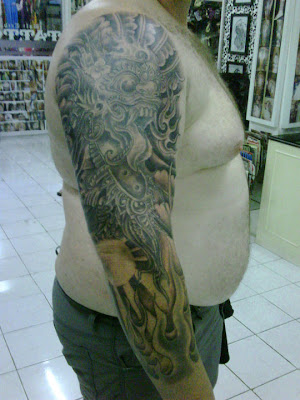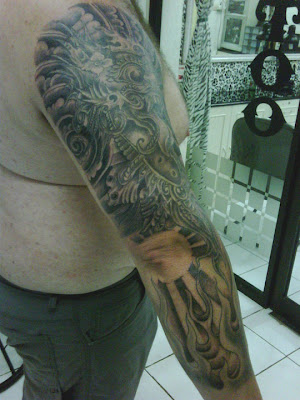A tattoo studio which is named 3 Datu tattoo studio, was opened in around 2008. 3 Datu itself means the three elements, namely the creator, maintainer and buster. This studio is located in North Padma, with Wayan Wijaya Enteg as the owner, Koming Chao as the tattoo artist which assisted by Manix and Leonk. This studio is also equipped with air conditioning, medical Sterilizer, Internet, and waiting rooms. Price determined by size, and difficulty level of the images itself. Most of the customers are come from Australia. They won’t receive any outgoing tattoo orders anymore, except for some close friends, because once, the artist almost been stabbed by a customer for some less obvious reasons, when receiving an outgoing tattoo orders. For you who are interested in the work of this artists (could be seen in www.3datutattoo.com) just go directly to Jl Werkudara no. 513, or you may contact the 3datu_tattoo@yahoo.co.id.
Indonesian version:
Studio yang dikasi nama 3 datu tattoo studio ini mulai buka sekitar tahun 2008. Diberi nama 3 datu yang artinya adalah 3 unsur yaitu Pencipta, pemelihara dan pelebur. Studio ini terletak di daerah Padma Utara, dengan Wayan Enteg Wijaya sebagai owner, Koming Chao sebagai tukang tato dan di bantu 2 orang staff, Manix dan Leonk. Studio ini juga sudah di lengkapi dengan AC, medical sterilizer, internet, dan ruang tunggu. Harga yang dipatok berdasarkan size,dan tingkat kesulitan gambar. Sebagian besar customer yang datang berasal dari Australia. Tidak menerima tato panggilan keluar studio, kecuali teman-teman dekat, karena pengalaman buruk sang artist pernah nyaris ditusuk salah satu customernya karena alasan yang kurang jelas, ketika menerima tattoo panggilan. Dan mungkin untuk kalian yang tertarik dengan hasil karya sang artist (bisa di lihat di www.3datutattoo.com) langsung saja menuju ke Jl Werkudara no.513 atau bisa kontak ke 3datu_tattoo@yahoo.co.id.
Sumber: magic-ink vol.10
Saturday, October 30, 2010
Friday, October 29, 2010

In summary, the SDSR outlines 8% cuts to the British defence budget with
the Royal Navy reduced by around 5,000 personnel, the British Army by 7,000, the RAF by around 5,000 and civilians reduced by around 25,000. Even the Telegraph admits that the MoD got off lightly in this months round of public sector cuts. RAF Kinloss in Scotland will close and Tornado fighters at Lossiemouth will transfer to the UK in a somewhat half-hearted bid to centralise and consolidate the strategic distribution of airbases around the UK. Other RAF bases may be 'repurposed' for use by the other armed services, and the massive MoD training site proposed for St Athan, Wales, is on permanent hold. All of which means that there will be very little difference to the overall size of the defence estate
MAGIC INK TATTOO CONTEST 2010
Sabtu (21/8), Magic Ink menyelenggarakan untuk pertama kalinya event Magic Ink Tattoo Contest 2010, terbagi menjadi 2 kategori yaitu Black & Gray dan Color, dengan mengambil tema Extreme Fantasy. 38 peserta yang didominasi studio tato di Bali dan juga beberpa peserta dari luar bali (malang, surabaya dan semarang) berebut 2 tempat terbaik di masing-masing kategori.
Dimulai sekitar pukul 11 siang, dan diisi oleh deretan band-band lokal Bali. The Rolic membuka acara..disusul The 2nd Home, fight back.. dan Dreizehn bikin suasana jadi luluh lantah oleh gempuran distorsi berkolaborasi dengan suara desing mesin tato. Nosstress naik panggung menenangkan suasana. Roy Parsua dan Angga El’Diablo sibuk sendiri berkolaborasi dipaha model mereka
Setelah itu penjurian dilaksanakan, jajaran juri diwakili artist tato (Ibud, Abuth, & Daplonk) lalu dari kalangan pelukis (Welldo) dan dari komunitas Sketch (Dede). Sambil menunggu perhitungan hasil penilaian, Pengunjung mendekat ke area Body Suspension dari Albar Tikam Suku Suku Tatau dan Oni Killcat.
Dan akhirnya hasil penilaian keluar dengan pemenang di Kategori Color adalah Mangku dari AS Tatto sebagai juara pertama dan Toge dari Radjah Skin Design diposisi kedua. Dikategori Black & Gray, Andre dari My Liberty menjadi juara dan Agung Star Tatoo ditempat kedua. Untuk best extreme fantasy dimenangi oleh Andre dari My Liberty melalui hasil voting penonton. The Hydrant yang hari itu menjadi bintang tamu, tampil terakhir sekaligus menutup acara.
Warung Kang Jaka berubah menjadi arena komunitas tato hari itu, ditambah lagi komunitas Harley yang datang siang itu, Ular-ular dari komunitas Barong, dan para tato artist yang sibuk menggambar di kertas menggunakan pensil arang..Thanks buat support para sponsor dan tentun saja para peserta dan pengunjung..Rock On..!
Sumber: magic-ink vol 10
Dimulai sekitar pukul 11 siang, dan diisi oleh deretan band-band lokal Bali. The Rolic membuka acara..disusul The 2nd Home, fight back.. dan Dreizehn bikin suasana jadi luluh lantah oleh gempuran distorsi berkolaborasi dengan suara desing mesin tato. Nosstress naik panggung menenangkan suasana. Roy Parsua dan Angga El’Diablo sibuk sendiri berkolaborasi dipaha model mereka
Setelah itu penjurian dilaksanakan, jajaran juri diwakili artist tato (Ibud, Abuth, & Daplonk) lalu dari kalangan pelukis (Welldo) dan dari komunitas Sketch (Dede). Sambil menunggu perhitungan hasil penilaian, Pengunjung mendekat ke area Body Suspension dari Albar Tikam Suku Suku Tatau dan Oni Killcat.
Dan akhirnya hasil penilaian keluar dengan pemenang di Kategori Color adalah Mangku dari AS Tatto sebagai juara pertama dan Toge dari Radjah Skin Design diposisi kedua. Dikategori Black & Gray, Andre dari My Liberty menjadi juara dan Agung Star Tatoo ditempat kedua. Untuk best extreme fantasy dimenangi oleh Andre dari My Liberty melalui hasil voting penonton. The Hydrant yang hari itu menjadi bintang tamu, tampil terakhir sekaligus menutup acara.
Warung Kang Jaka berubah menjadi arena komunitas tato hari itu, ditambah lagi komunitas Harley yang datang siang itu, Ular-ular dari komunitas Barong, dan para tato artist yang sibuk menggambar di kertas menggunakan pensil arang..Thanks buat support para sponsor dan tentun saja para peserta dan pengunjung..Rock On..!
Sumber: magic-ink vol 10
Wednesday, October 27, 2010
How to choose a tattoo studio
So you have decided about the tattoo design and the location of the tattoo on your body. Now it is time to select the right place where you can get it done properly. Of course it is the tattoo studio but you should check the following in this regard...
- You should first of all check the Tattoo Artist certifications.
- You should check the autoclave and sterilization certifications
- You should make sure that artist wears protective gloves.
- You should be sure about the cleanliness of the equipments that are being used in the process of tattooing.
- You should properly observe that the ointments, ink and water used for the purpose are taken from separate and clean containers.
- You should insist that sterile or new needles should be taken from an autoclave bag in front of you.
- And after the use the needles should be disposed off appropriately.
- You should also insist on the use of fresh inks used as the color of the tattoos.
- Also make sure that each color of ink comes from a bottle that is poured into a small cup specifically for your tattoo.
- Satisfy yourself by ensuring that neither a needle is reused nor the remains of prior used ink could be used on you.
- You should see prior designs of tattoos made by the artists in the studio.
- You should allow the Tattoo Artist touch your skin only after being fully satisfied about his talent.
- Never mind even if it takes a long time to find a neat and clean parlor as well as the artist.
- After all it is the question of health and hygiene.
Tuesday, October 26, 2010
Dragon Designs by Bali Dreamz Tattoo
Labels:
Bali,
Black,
Dragon Tattoo,
Flower Tattoo,
Hand,
red fire,
Yellow
Tuesday, October 19, 2010
Gouache Paintings in Small Scale--launching a new medium
Although I have not and do not plan to print or sell the book "Landscape Painting in Pastels", I have designed a modest little book containing some of my gouache landscapes, which I want to share with you.
It's quite a nice little softcover book. Most of the work shown is landscapes, although I included some of my still life and floral paintings. There are 68 paintings and three step-by-step demonstrations (all landscapes), as well as the text of the article that was in Watercolor Artist magazine in February, called Emergency Inspiration Kit. I've had a lot of paintings shown in magazines, due to my association as a writer for The Pastel Journal, The Artist's Magazine, and Watercolor Artist over the last 12 years, so I was a bit skeptical about the quality that an online publisher such as Blurb could produce. I worked hard to lay it out so that the paintings are life-sized. The book itself is only 7" x 7" in size. The intimacy of this scale is well suited to showcasing these 2.5" x 3.5" paintings.
So let me reiterate that although this is not a big, impressive book, it is a very nice little collection of photographs that pretty accurately represents my paintings, and I'm most pleased with it. I'm quite happy to offer it for sale to anyone who is interested. I kept the price modest, of course, and you can preview every page, so you'll know what you're getting.
I'm so pleased with the quality of this small book that I plan to design one devoted to a retrospective of my pastel landscapes in the near future, but I hope you'll enjoy seeing my most current work in gouache.
I hope you enjoy it.
It's quite a nice little softcover book. Most of the work shown is landscapes, although I included some of my still life and floral paintings. There are 68 paintings and three step-by-step demonstrations (all landscapes), as well as the text of the article that was in Watercolor Artist magazine in February, called Emergency Inspiration Kit. I've had a lot of paintings shown in magazines, due to my association as a writer for The Pastel Journal, The Artist's Magazine, and Watercolor Artist over the last 12 years, so I was a bit skeptical about the quality that an online publisher such as Blurb could produce. I worked hard to lay it out so that the paintings are life-sized. The book itself is only 7" x 7" in size. The intimacy of this scale is well suited to showcasing these 2.5" x 3.5" paintings.
So let me reiterate that although this is not a big, impressive book, it is a very nice little collection of photographs that pretty accurately represents my paintings, and I'm most pleased with it. I'm quite happy to offer it for sale to anyone who is interested. I kept the price modest, of course, and you can preview every page, so you'll know what you're getting.
I'm so pleased with the quality of this small book that I plan to design one devoted to a retrospective of my pastel landscapes in the near future, but I hope you'll enjoy seeing my most current work in gouache.
I hope you enjoy it.
Friday, October 15, 2010
The End
Now that the book is concluded I want to acknowledge the help and support of my family and friends.
My husband Dan has been of immeasurable assistance to me every step of the way. He helps me to keep my priorities straight, guiding me gently and lovingly to see the Lord's will in my life. I can't tell you how many times he has taken a question into consideration, prayed and then come back to me with wonderful Scriptural support. We discussed at length publishing this book free of any charge, giving it away to all, something many people would have viewed as merely an opportunity for income. Dan saw the bigger spiritual picture first and urged me to live what I believe. Thank you, my love.
I also want to mention the ways my son, Chris, has been of service. He's one of my finest critics and most supportive fans. He's honestly looked at my work, asked some good questions, occasionally attended classes I taught, and has always reminded me that I'm an artist, in addition to being a child of God, wife, mom and daughter. Thank you, kiddo. Sometimes I need to remember that.
Each week as I've posted these chapters I've also relied on the expertise of Phil van Hulle. We met online at WetCanvas, where he volunteered his considerable experience and expertise in editing the chapters. Anyone who writes knows the value of excellent editing. At first I reviewed all the changes one by one, but in a very short time I recognized that each change clarified what I was saying and was very respectful of the content. Soon I simply clicked on the 'accept all changes' button quite confidently. Phil, thank you so much.
And I want to thank all of the readers up to now and yet to come. I've received so many wonderful messages from people telling me they are learning and trying new things. I'm delighted to know how these chapters help the beginner get started or the more experienced artist move forward. I've even heard form a couple of seasoned pros that they're enjoying the exploration of some subjects.Your encouragement means a lot to me. Thank you to each and every one of you.
I've said it for years to my students. Now let me say it to all of you:
Deborah Secor
Albuquerque
October 15, 2010
My husband Dan has been of immeasurable assistance to me every step of the way. He helps me to keep my priorities straight, guiding me gently and lovingly to see the Lord's will in my life. I can't tell you how many times he has taken a question into consideration, prayed and then come back to me with wonderful Scriptural support. We discussed at length publishing this book free of any charge, giving it away to all, something many people would have viewed as merely an opportunity for income. Dan saw the bigger spiritual picture first and urged me to live what I believe. Thank you, my love.
I also want to mention the ways my son, Chris, has been of service. He's one of my finest critics and most supportive fans. He's honestly looked at my work, asked some good questions, occasionally attended classes I taught, and has always reminded me that I'm an artist, in addition to being a child of God, wife, mom and daughter. Thank you, kiddo. Sometimes I need to remember that.
Each week as I've posted these chapters I've also relied on the expertise of Phil van Hulle. We met online at WetCanvas, where he volunteered his considerable experience and expertise in editing the chapters. Anyone who writes knows the value of excellent editing. At first I reviewed all the changes one by one, but in a very short time I recognized that each change clarified what I was saying and was very respectful of the content. Soon I simply clicked on the 'accept all changes' button quite confidently. Phil, thank you so much.
And I want to thank all of the readers up to now and yet to come. I've received so many wonderful messages from people telling me they are learning and trying new things. I'm delighted to know how these chapters help the beginner get started or the more experienced artist move forward. I've even heard form a couple of seasoned pros that they're enjoying the exploration of some subjects.Your encouragement means a lot to me. Thank you to each and every one of you.
I've said it for years to my students. Now let me say it to all of you:
It's looking good. Keep going!
Deborah Secor
Albuquerque
October 15, 2010
Wednesday, October 6, 2010
CHAPTER THIRTY-FIVE -- THE FIRST GALLERY
The long-planned day has arrived. Today is the day you approach your first gallery. You’ve painted those six excellent pieces, had your mentor critique them, and have them nicely framed. You’ve shopped the galleries to find the top four in your target market and found the one you most want to show in, as well as determining how it reviews work. You have business cards, a brochure with some details about you and your art, a résumé listing the few shows you’ve been in, and an artist’s statement, all organized in your portfolio alongside excellent photos of your artwork. Now all you need to do is show the work and pray like crazy it’s accepted.
If some of these suggestions seem daunting, I suggest you take some time to study information devoted to marketing your work. There are some excellent resources in print and online explaining the ins and outs of making cards, brochures, portfolios and prints, not to mention articles in arts magazines with handy tips and cost-cutting information. Be sure that whatever you do fits your personality and artwork. Try to think things through from the point of view of the gallery owner or director before entering the door.
I suggest framing five paintings in three sizes, two small, two medium and one large. Show paintings that have a cohesive look, presenting a nice show hanging together on a wall.
ON THE DAY
If you are given a review date, ask what to prepare and arrive on time with everything they request. If you decide to walk in and discuss the possibility of showing with a gallery director, qualify the galleries you’ve chosen before going there. Make sure it’s the right place, or at least in your top four choices.
Prepare to go into the gallery at a very quiet time of day, with a relatively small portfolio. Dress professionally, relative to the market you’re entering. Don’t go in your paint spattered, ripped jeans or lug in a large framed painting. You should be able to carry your portfolio in one hand or on a strap over your shoulder. The sales clerk or director will spot you as an artist a mile off, so don’t try to pretend to be a shopper. Ask if it’s possible to speak to the director or owner. As soon as she approaches, tell her your name and identify yourself as an artist looking for representation. Smile, look her in the eye and be prepared to hear that they are not accepting work at this time. Ask when and how she reviews work. Have a business card ready to hand her with a smile, and offer to leave photographs, if she seems interested. Prepare a small photograph album containing your ten best paintings in a cohesive style, labeled with title, size, and medium. List your contact information inside and offer to leave it with the director if she isn’t open to reviewing work.
If she’s open to discussion, take the time to talk. Ask questions about the work or the gallery. A little schmoozing is acceptable as long as it doesn’t take too much time and doesn’t draw the director away from clients. Ask if you can show the photos of your work, but have a small framed painting inside your portfolio, too. When you open the zipper to retrieve your photo album, make sure your painting is visible. If she is interested in seeing your artwork, do not spread paintings around the gallery floor unless the director tells you to, and never, ever interrupt anyone working with clients. You’re there to support the work of the gallery. Your spouse or a friend should help you retrieve paintings, and hold back all but the two you carry in—your two best, of course.
As you show the work, talk about what you do. If this idea is hard for you, discuss with your mentor or a friend two things you can point out about each painting. You want to give the gallery a sales pitch they can give to a client, something like the location of the subject matter, a special color you used, or an experience you had painting it.
ACCEPTED
The director just asked you to consign work. Now what? Be prepared to read over any consignment contract the gallery may want signed, which is for your protection as well as theirs. Don’t quibble over details unless you feel that what they’re suggesting is outside the norm. Read sample contracts so that you’re clear on what’s standard. There are many showing online that you can peruse ahead of time.
Carry two copies of a short, simple consignment form in your portfolio, left blank so that you can fill in the gallery name and address, as well as the titles, sizes and prices of your paintings, should the owner want to take the work immediately. Most often a gallery will offer you a form, since paperwork is part of what you’re paying them to do. Don’t be afraid to ask about policies such as how often the gallery pays its artists and whether it sends notice when nothing has sold. (Most don’t.) This is professional and expected.
They want to accept all your paintings today and ask if you can deliver a few more in a week or two. Many galleries prefer to have some back stock so that they can rotate work or show interested customers more paintings. Be prepared ahead of time. Have three or four additional paintings stored at home ready to frame. If you don’t have the work, be honest and let them know when you can deliver it. Do not run home to paint four more and try to deliver them in a week. It won’t work, trust me. If you have work available, show photographs or agree to send digital shots via e-mail as soon as you can. It’s best to develop a good working relationship with the gallery by asking which paintings the owners want to show. You can always slip in a couple of your other painting subjects when you consign, if you don’t mind framing them at the risk of having them turned down. Determine some standard sizes you will use so that you can replace one painting with another.
It’s always a good idea to ask when the gallery would prefer to accept deliveries of your paintings. Some busy galleries won’t consign on Saturday afternoon, for instance, so be sure to let them know when to expect you, and arrive on time. Whenever you show up at the gallery, carry framed work in with cardboard corners in place. (I carried my framed work in homemade canvas bags for years, sized to accommodate three or more paintings that I could easily transport myself. This allowed me to come in quietly and unobtrusively, without making too many trips, and I could quickly corral corners to carry away when finished.) Ask where they would like you to place the paintings. Stack your consigned paintings in one spot and request that the sales clerk or director sign your already-filled-out consignment form as you count and read the titles of the paintings to her. You can always line out anything that isn’t consigned, and initial beside the title, if she doesn’t want it. Even if the gallery has paperwork it wants filled out, I suggest you have a neat little consignment form of your own. If nothing else, they can copy titles and sizes from your typed copy. Save them time, trouble and hassle!
Once your business is transacted, clear out anything taking up space, and if you have time return to the gallery to look at the work. Notice the prices, review the framing styles, look at the lighting, the displays, etc. You’re in partnership with the gallery to sell work, so take note of the business. Ask what’s selling, and admire the work you see. Keep a consignment list in your pocket and check your inventory to see that it’s displayed, that the price is correct, and that it’s clean and well-lighted. If needed, problems with any of these issues can be taken up later, over the phone or via e-mail. Take a photograph of the wall holding your work for future reference, if the gallery doesn’t object.
CONCLUSION
There’s far more to dealing with galleries than I can detail here, of course. Some have likened a gallery-artist relationship to marriage, and there’s some truth to that -- aside from “‘til death do us part.” Your job is to provide good work, ready to display, in a timely fashion. Their job is to represent you well and show and sell your work. Each partner must do the job well to make the relationship flourish.
When you encounter problems, think through how you want to solve things and approach the gallery personnel with respect. Remember that you’re one of many artists they deal with, so try to maintain a strong working relationship that’s built on mutual benefits. Determine that above all, as much as it depends on you, you’ll keep your word and try to consider things from the other’s point of view.
When you find a trusted gallery owner who can market your work well, you may develop a longtime working relationship that benefits both of you. The bottom line is to always seek out how you can support the gallery. Be sure to express your appreciation for the hard work the owners do. Thank them for sales -- send an e-mail or write a little note once in a while. You are in this together.
| Portfolio--present all one genre (remove the portrait.) |
The long-planned day has arrived. Today is the day you approach your first gallery. You’ve painted those six excellent pieces, had your mentor critique them, and have them nicely framed. You’ve shopped the galleries to find the top four in your target market and found the one you most want to show in, as well as determining how it reviews work. You have business cards, a brochure with some details about you and your art, a résumé listing the few shows you’ve been in, and an artist’s statement, all organized in your portfolio alongside excellent photos of your artwork. Now all you need to do is show the work and pray like crazy it’s accepted.
If some of these suggestions seem daunting, I suggest you take some time to study information devoted to marketing your work. There are some excellent resources in print and online explaining the ins and outs of making cards, brochures, portfolios and prints, not to mention articles in arts magazines with handy tips and cost-cutting information. Be sure that whatever you do fits your personality and artwork. Try to think things through from the point of view of the gallery owner or director before entering the door.
I suggest framing five paintings in three sizes, two small, two medium and one large. Show paintings that have a cohesive look, presenting a nice show hanging together on a wall.
- Choose paintings that show consistent style. (Yes, you do have a style, even if you can’t identify it. Ask someone else to help you select the work if you can’t be objective yourself).
- Select work that overlaps certain colors or themes, but isn’t all identical (not six sunset paintings). Even if it’s your favorite painting ever and won a prize at the fair, if it sticks out as being too different it won’t complement the showing.
- Stick with one genre: all figures in the landscape, all still life, all portraits. This gives the gallery an identifier they can use to sell your work. Later you may add other subject matter.
- Be sure that your paintings are framed in a style that suits the area. Look around at what’s selling before you frame your work and take mat color and style of frame into consideration. Frame all of the work in similar frames and mat colors. You want a consistent, professional look, not a garage sale look.
- Have reasonable prices in mind for each piece, taking into consideration the 50 percent commission fee you’ll likely give the gallery. Once accepted, don’t hesitate to ask the gallery director or owner whether these prices are in line with what she expects to get, or whether they want you to go higher or lower. Be flexible -- you’re getting valuable advice from a professional you plan to do business with, so such questions show you respect them.
ON THE DAY
If you are given a review date, ask what to prepare and arrive on time with everything they request. If you decide to walk in and discuss the possibility of showing with a gallery director, qualify the galleries you’ve chosen before going there. Make sure it’s the right place, or at least in your top four choices.
Prepare to go into the gallery at a very quiet time of day, with a relatively small portfolio. Dress professionally, relative to the market you’re entering. Don’t go in your paint spattered, ripped jeans or lug in a large framed painting. You should be able to carry your portfolio in one hand or on a strap over your shoulder. The sales clerk or director will spot you as an artist a mile off, so don’t try to pretend to be a shopper. Ask if it’s possible to speak to the director or owner. As soon as she approaches, tell her your name and identify yourself as an artist looking for representation. Smile, look her in the eye and be prepared to hear that they are not accepting work at this time. Ask when and how she reviews work. Have a business card ready to hand her with a smile, and offer to leave photographs, if she seems interested. Prepare a small photograph album containing your ten best paintings in a cohesive style, labeled with title, size, and medium. List your contact information inside and offer to leave it with the director if she isn’t open to reviewing work.
If she’s open to discussion, take the time to talk. Ask questions about the work or the gallery. A little schmoozing is acceptable as long as it doesn’t take too much time and doesn’t draw the director away from clients. Ask if you can show the photos of your work, but have a small framed painting inside your portfolio, too. When you open the zipper to retrieve your photo album, make sure your painting is visible. If she is interested in seeing your artwork, do not spread paintings around the gallery floor unless the director tells you to, and never, ever interrupt anyone working with clients. You’re there to support the work of the gallery. Your spouse or a friend should help you retrieve paintings, and hold back all but the two you carry in—your two best, of course.
As you show the work, talk about what you do. If this idea is hard for you, discuss with your mentor or a friend two things you can point out about each painting. You want to give the gallery a sales pitch they can give to a client, something like the location of the subject matter, a special color you used, or an experience you had painting it.
ACCEPTED
The director just asked you to consign work. Now what? Be prepared to read over any consignment contract the gallery may want signed, which is for your protection as well as theirs. Don’t quibble over details unless you feel that what they’re suggesting is outside the norm. Read sample contracts so that you’re clear on what’s standard. There are many showing online that you can peruse ahead of time.
Carry two copies of a short, simple consignment form in your portfolio, left blank so that you can fill in the gallery name and address, as well as the titles, sizes and prices of your paintings, should the owner want to take the work immediately. Most often a gallery will offer you a form, since paperwork is part of what you’re paying them to do. Don’t be afraid to ask about policies such as how often the gallery pays its artists and whether it sends notice when nothing has sold. (Most don’t.) This is professional and expected.
They want to accept all your paintings today and ask if you can deliver a few more in a week or two. Many galleries prefer to have some back stock so that they can rotate work or show interested customers more paintings. Be prepared ahead of time. Have three or four additional paintings stored at home ready to frame. If you don’t have the work, be honest and let them know when you can deliver it. Do not run home to paint four more and try to deliver them in a week. It won’t work, trust me. If you have work available, show photographs or agree to send digital shots via e-mail as soon as you can. It’s best to develop a good working relationship with the gallery by asking which paintings the owners want to show. You can always slip in a couple of your other painting subjects when you consign, if you don’t mind framing them at the risk of having them turned down. Determine some standard sizes you will use so that you can replace one painting with another.
It’s always a good idea to ask when the gallery would prefer to accept deliveries of your paintings. Some busy galleries won’t consign on Saturday afternoon, for instance, so be sure to let them know when to expect you, and arrive on time. Whenever you show up at the gallery, carry framed work in with cardboard corners in place. (I carried my framed work in homemade canvas bags for years, sized to accommodate three or more paintings that I could easily transport myself. This allowed me to come in quietly and unobtrusively, without making too many trips, and I could quickly corral corners to carry away when finished.) Ask where they would like you to place the paintings. Stack your consigned paintings in one spot and request that the sales clerk or director sign your already-filled-out consignment form as you count and read the titles of the paintings to her. You can always line out anything that isn’t consigned, and initial beside the title, if she doesn’t want it. Even if the gallery has paperwork it wants filled out, I suggest you have a neat little consignment form of your own. If nothing else, they can copy titles and sizes from your typed copy. Save them time, trouble and hassle!
Once your business is transacted, clear out anything taking up space, and if you have time return to the gallery to look at the work. Notice the prices, review the framing styles, look at the lighting, the displays, etc. You’re in partnership with the gallery to sell work, so take note of the business. Ask what’s selling, and admire the work you see. Keep a consignment list in your pocket and check your inventory to see that it’s displayed, that the price is correct, and that it’s clean and well-lighted. If needed, problems with any of these issues can be taken up later, over the phone or via e-mail. Take a photograph of the wall holding your work for future reference, if the gallery doesn’t object.
CONCLUSION
There’s far more to dealing with galleries than I can detail here, of course. Some have likened a gallery-artist relationship to marriage, and there’s some truth to that -- aside from “‘til death do us part.” Your job is to provide good work, ready to display, in a timely fashion. Their job is to represent you well and show and sell your work. Each partner must do the job well to make the relationship flourish.
When you encounter problems, think through how you want to solve things and approach the gallery personnel with respect. Remember that you’re one of many artists they deal with, so try to maintain a strong working relationship that’s built on mutual benefits. Determine that above all, as much as it depends on you, you’ll keep your word and try to consider things from the other’s point of view.
When you find a trusted gallery owner who can market your work well, you may develop a longtime working relationship that benefits both of you. The bottom line is to always seek out how you can support the gallery. Be sure to express your appreciation for the hard work the owners do. Thank them for sales -- send an e-mail or write a little note once in a while. You are in this together.
Subscribe to:
Posts (Atom)










